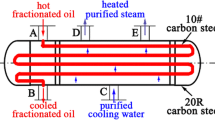Abstract
An inspection of the floor in a bubbling fluidized-bed power boiler during a planned shutdown revealed significant corrosion of the type 310H stainless steel (UNS S31009) bed nozzles. One severely corroded bed nozzle was removed, along with samples of the deposit encasing the surface of the bed nozzle, for a subsequent failure analysis. The deposit covering the external (fireside) surface of the bed nozzle was almost entirely sodium and potassium chlorides, which covered a thick layer of corrosion product on the bed nozzle surface. The corrosion product was predominantly oxides of chromium, nickel, and iron. Chlorides were also found interspersed through the layer of corrosion product. It is concluded that the fireside corrosion was predominantly caused by chlorine-containing compounds (active oxidation). Overheating induced by the fouling, particularly within the air holes, is believed to be a major factor influencing corrosion.
Similar content being viewed by others
References
R.J. Bishop: “The Formation of Alkali-Rich Deposits by a High-Chlorine Coal,” J. Inst. Fuel, 1968, 41, p. 51.
R.J. Bishop and K.F. Cliffe: “Condensation Behaviour of Sodium Chloride during Convective Heat Transfer,” J. Inst. Fuel, 1970, 43, p. 441.
D.W. McKee, D.A. Shores, and K.L. Lurthra: “The Effects of SO2 and NaCl on High Temperature Hot Corrosion,” J. Electrochem. Soc., 1978, 125(3), p. 411.
K. Iisa, Y. Lu, and K. Samenoja: “Sulfation of Potassium Chloride at Combustion Conditions,” Energy Fuels, 1999, 13(6), p. 1184.
M. Orjala, R. Ingalsuo, K. Paakkinen, J. Hämäläinen, M. Mäkipää, M. Oksa, T. Malkow, R.J. Fordham, and D. Baxter: “How to Control Superheater Tube Corrosion in FB Boilers Which Use Wood and Wood Waste as Fuel,” Proceedings of the Tenth International Symposium on Corrosion in the Pulp and Paper Industry, vol. 1, T. Hakkarainen, ed., VTT, Espoo, Finland, 2001, p. 117.
H.J. Grabke, E. Reese, and M. Spiegel: “The Effects of Chlorine, Hydrogen Chloride and Sulphur Dioxide in the Oxidation of Steels below Deposits,” Corros. Sci., 1995, 37, p. 1023.
Y. Shinata, F. Takahashi, and K. Hashiura: “NaCl-Induced Hot Corrosion of Stainless Steels,” Mater. Sci. Eng., 1987, 87, p. 399.
A.J.B. Cutler, W.D. Halstead, J.W. Laxton, and C.G. Stevens: “The Role of Chloride in the Corrosion Caused by Flue Gas and Their Deposits,” J. Eng. Power (Trans. ASME), 1971, 93(7), p. 307.
N. Hiramatsu, Y. Uematsu, T. Tanaka, and M. Kinugasa: “Effects of Alloying Elements on NaCl-Induced Hot Corrosion of Stainless Steels,” Mater. Sci. Eng., 1989, A120, p. 319.
Author information
Authors and Affiliations
Rights and permissions
About this article
Cite this article
Prescott, R., Kish, J.R. & Singbeil, D.L. Fouling and corrosion of bed nozzles in a bubbling fluidized-bed power boiler. J Fail. Anal. and Preven. 6, 65–72 (2006). https://doi.org/10.1361/154770206X117531
Received:
Revised:
Issue Date:
DOI: https://doi.org/10.1361/154770206X117531




